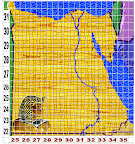Standards-9987
Standard Font Size for Glyphs
Have you ever clicked on a web page and the text color is close to the background color... ugh ! or, have you ever went to a page and the font size is so small you had to strain to see it or adjust your screen?
When people printed on paper, they would often use a very small font size to save on the cost of printing, but in digital text, there is no reason why the image should not be large enough for the average bear to see. If it is too big, it is still OK.
=============================
Glyph standard size
= When the largest glyph, can still be clearly seen.Some glyphs are small and a simple design. Other glyphs are larger and have lots of detail.
The formula for creating the standard size for all glyphs would be
a) Find the glyph which
b) When shrunk to the smallest size
c) Could still be clearly seen
Say 1" x 1" .. all glyphs would conform to that size.
I guess those are two different kind of birds. Before assigning glyph numbers as a standard, there should be an extensive study to find glyphs similar in design to others and those glyphs all be clustered together, so when scholars learned the system, they could see the close glyphs side by side and see the small differences.
In this example you would notice the difference in 101 and 102
=============================
Because "modern" media integrated the type writer..... type, type, type... when moving so far, there would be a carriage return, drop down to the next line. The same thing happens with our word processors "word wrap"
It is pretty hard to chisel small letters in stone. I am guessing lots of hieroglyphic letters are larger than 1 inch.
=============================
No matter how large the font, if needed the complete line could remain on one line. Scrolling with the left/right arrows would display all the glyphs on that line.
=============================
a) Agree on a standard size for all fonts based on the largest / most detailed glyph.
b) Arrange glyphs based on similarities
c) Number the glyphs.
d) Just like the HTM format which can be used by the world freely, make the standard hieroglyphic format free to all .
=============================
All glyphs would be assigned a 4 digit number, so all glyphs smaller than 1000 would be padded on the right with zeros.
This 4 digit numbering system will be essential later...
~
~
zendz


No comments:
Post a Comment